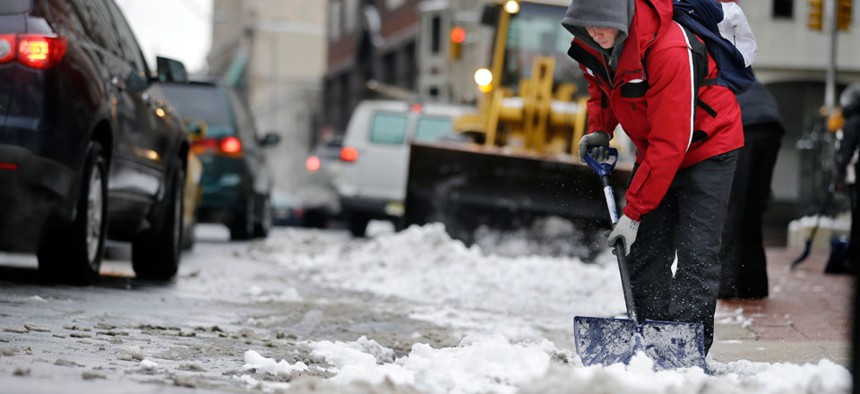
Workers clear newly-fallen snow from a street, Tuesday, Feb. 18, 2014, in Trenton, N.J. Mel Evans/AP
The U.S. Government's Amazingly Wrong Forecast for This Winter
It predicted "above-normal" temperatures. Oops.
One of the many responsibilities of the U.S. federal government is to play the role of American Oracle. The Congressional Budget Office tells us how laws, like tax cuts and Obamacare, will affect the economy in the next decade. And the Climate Prediction Center of the National Oceanic and Atmospheric Administration tells us what sort of weather to expect in the next few months.
Oh wow, was it wrong this year.
The official forecast for November 2013 through January 2014 anticipated "above normal" temperatures for the swath of the continental U.S. stretching from Maine to Baja, California. Above normal.
Then reality intervened, and, yes, "above normal" might describe your heating bill, your show-shoveling-calories burned, or the degree to which you are ready to sell your house and move to Mexico. But it certainly doesn't describe the national temperature during a winter that has set records and near-records for frigidness across the Great Plains and Northeast. Compare the swoosh of red (predicted, above) to the block of blue (reality, below).
“Not one of our better forecasts,” admitted Mike Halpert, the Climate Prediction Center’s acting director. Bloomberg Businessweek' s Peter Coy , whose piece clued me in to this report, explains that the center grades itself on a spectrum ranging from 100 (totally right) to -50 (completely wrong). "October’s forecast for the three-month period of November through January came in at -22," Coy reported. "The September prediction for October-December was slightly worse, at -23." The December cold wave followed by the massive polar vortex basically smashed the agency's three-month temperature model.
We shouldn't be too surprised. Meteorology has made tremendous strides with predicting temperature and precipitation within 24- and 48-hour periods. But once you get past eight days, chaos reigns. And when you get out past a week, and you're predicting climate's effect on temperature, your estimates become exquisitely sensitive to the smallest consequential changes. In fact, the Butterfly Effect—the idea that a butterfly's wings in Brazil can trigger a tornado in Texas—comes from a 1972 paper on chaos theory by Edward Lorez, a former meteorologist.
The trouble with predicting the next three months of temperatures is that weather is a dynamic system, where small changes can yield huge variances in outcomes. After a little more than a week, predictive models are swarmed by the butterfly wings of chaos. Nate Silver offered a useful metaphor for the difficulty of longer-term weather projections in his book, The Signal and the Noise :
Think of the atmosphere as akin to a NASCAR oval, with various weather systems represented by individual cars that are running along the track. For the first couple of dozen laps around the track, knowing the starting order of the cars should allow us to make a pretty good prediction of the order in which they might pass by ...
Soon, however, the faster cars will start to lap the slower ones, and before long the field will be completely jumbled up. Perhaps the second-placed car is running side by side with the sixteenth-placed one (which is about to get lapped), as well as the one in the twenty-eighth place (which has already been lapped once and is in danger of being lapped again). What we knew of the initial conditions of the race is of almost no value to us.
Likewise, once the atmosphere has had enough time to circulate, the weather patterns bear so little resemblance to their starting positions that the models don’t do any good.
Since weather forecasts break down after about a week, the Climate Prediction Center uses different variables to build months-long climate forecasts. These broader forecasts take into account more enduring variables, like the temperature of the ocean, which determine whether a season's weather patterns are more likely to be hot vs. cold or wet vs. dry. It's an entirely different formula from the seven-day forecast you'll see on your local news or iPhone. But, just like your local meteorologist, the federal government's official climate prognosticators don't have a perfect record—and this is a particularly good reminder to regard all federal forecasts with skepticism.








